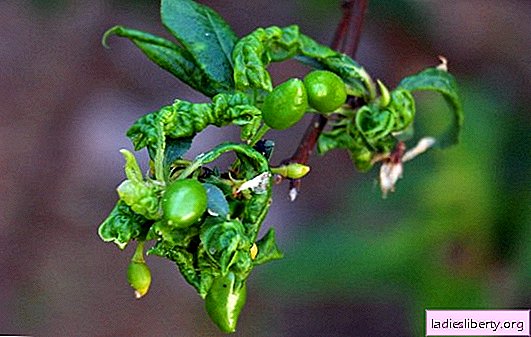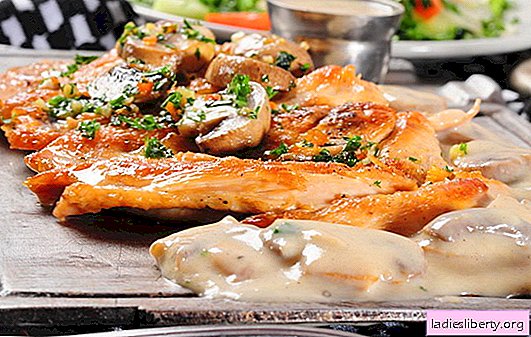
Plums, like other fruit crops, are at risk of contracting pests and diseases.
Fungal and viral infections, insect damage can lead to loss of yield and even death of trees.
It happens that the plum dries, the leaves of the plum twist, and it is difficult to understand why this is happening. And there are many reasons for this state of trees, because plums have many diseases and pests.
But, if you look closely, the signs of tree damage and the course of the disease are different. To find the source of the problem, you need to identify the "culprit" - the pest or infection that hit the plum.
Plum: pests and diseases
The reason that the plum dries may be diseases that affect all or many species of fruit trees or are inherent only in this culture of the disease. Drying may be based on non-infectious physiological factors.
Disease
With infectious drying of stone fruit gardeners encountered in the early twentieth century. What is its cause? These are mainly fungal and viral infections.
Cytosporosis
Cytosporosis is a common fungal disease of fruit trees: first the bark patches dry, then the branches die in this place. The disease is life threatening to the tree. Cytosporosis infection most often threatens weakened plants with damaged bark. "Cytosporous" areas turn red. Numerous dark mushroom pycnids ("goose bumps") are formed in the affected cortex, randomly scattered across the affected surface.
Cytosporosis

A preventive measure is proper agricultural technology. Be sure to cover up the cuts of the branches with garden varieties, remove and burn all dry branches and dried fruits.
It is possible to treat a tree from cytosporosis only in the initial stages of the disease, until the fungus has infected the deep tissues of the plant. A sharpened knife removes damaged areas, capturing healthy wood by two centimeters. In order to disinfect the wounds, they are treated with copper sulfate (2% solution) and covered with garden var.
Verticillin wilt, or wilt, or wood mobile
Soil fungus that enters the plant through the roots. Infection affects many types of plants (about four hundred).
The first manifestation of wilt is the wilting of leaves in the middle or end of summer. The process begins at the bottom of the branches, gradually rising and capturing young shoots. Plum leaves begin to curl and dry. Premature leaf fall by the first of August can bare the trees completely. Often leaves fly around from separate branches or parts of the crown. Only on the tops of annual shoots are young leaves visible. There are acute and chronic forms.
On the leaves, the fungus forms microsclerotia, which remain viable in the soil for up to 8 years. A dark ring of dead vessels is noticeable on the branch cut.
Wilt

Late blight
Blight, it turns out, affects not only vegetables, but also trees. When this fungus is damaged, the whole tree dries out, while verticillosis usually causes the death of individual branches.
Wound parasite, releases strong toxins. It affects all rosaceae, legumes, and conifers. Causes root rot, rot of bark, wood and fruit.
Phytophthora (root rot)

Development Conditions:
• increased soil moisture;
• t> 25˚С;
• the presence of wounds on the roots;
• susceptible stocks;
• warm winters.
The fungus is stored in the soil. In the spring, it infects the roots of plants. Mycelium slowly develops in the roots of plums, killing them with toxins and causing blockage of blood vessels. A tree dies in two to three years.
Moniliosis
May cause drying of individual branches. With severe infection, the tree dies. There are two forms of moniliosis: a monilial burn and fruit rot.
Monilial burn is rampant in spring in the flowering phase. Infection penetrates plant tissue through the pistils of flowers. Then it spreads along the branches, causing them to dry out. Leaves and young shoots blacken and die, becoming like charred and charred.
For the spread of moniliosis during flowering, conditions of high humidity at low temperature are favorable.
Control measures.
• Agrotechnical:
- Before the swelling of the kidneys - removal, pruning of dead branches; collection and disposal of dead ovaries and fruits.
- In the flowering phase - pruning and disposal of infected branches with the capture of 10-15 cm of healthy tissue.
- Before harvesting - the collection and destruction of carrion.
• Chemicals:
- From the swelling of the buds to the beginning of flowering - treatment with a 1% Bordeaux mixture or Abiga-peak 8.5-9.6 kg / ha.
- During flowering, chorus 0.2-0.35 kg / ha is used.
- If the weather is wet after flowering, they are sprayed with 0.2 kg / ha chorus or 0.2 l / ha soon.
From the manifestation of moniliosis on the fruit (fruit rot), if signs of the disease are detected, they are sprayed soon 0.2 l / ha or Abiga-peak 4.8 kg / ha. Processing is carried out at the beginning of ripening.
Smallpox plum
It is expressed by the appearance of pale spots of various shapes on the leaves. With the development of the disease, the leaves become marble, yellow-green. Dark green stripes and rings appear on the fruits. The fruits are deformed and fall off. Leaves dry out. There is premature leaf fall. The next stage of the disease is the drying of the branches, then the whole tree.
The disease is spread with planting and vaccination material. The aphids are carriers of infection.
Smallpox can destroy an entire garden. It is a quarantine disease. There are no effective ways to deal with the shark.
Pests
Pollinated aphid plum
Winters in the phase of eggs, which are located at the base of the kidneys, in the cracks of the cortex. During budding in early April, larvae hatch, which attach to the first young leaves. In the first generation, there are few larvae, and colonies are found after the end of flowering of plum when the larvae of the second generation appear. The pest causes noticeable damage to leaves, flowers and fruits. Damaged leaves turn yellow along the veins, the flowers dry out, the fruits fall off, because of this, the yield can be significantly reduced.
Aphid

Control measures.
• Agrotechnical:
- When pruning, cut shoots populated by wintering aphid eggs and remove root shoots.
• Chemicals:
- In the early spring, spraying with the drug No. 30 is carried out.
- If there is a pest before flowering or immediately after it, treatment with fufanone, CE 1 l / ha, or ash with a consumption rate of 2 l / ha, or Danadim, CE 2 l / ha should be carried out.
Common spider mite
Females hibernate under fallen leaves, exfoliated bark. In spring, during flowering, they move to leaves, where they multiply, forming large colonies on the upper and lower sides of the leaf. With increasing numbers, the leaves are densely covered with cobwebs. The tick sucks the cell sap from the plant.
After shedding a significant number of leaves, the tree may die. The tick is very small, oval in shape. The color is variable and depends on the time of the year: at the beginning of summer the body is grayish-green with dots on the sides, from the last days of summer to spring it acquires an orange-red color.
Control measures.
• Agrotechnical:
- Destruction of weeds, cleaning the stems from the old dead bark and whitewashing them with lime in the fall.
• Chemicals:
- In the early spring to the beginning of budding, if there is a threshold of severity, treatment with drug No. 30 should be carried out.
- After flowering has ended, plum trees are sprayed with plum tree, or danadim, or bitoxibacillin at the time of fruit ripening.
A strong population of trees with other insects, for example, scabies, can also lead to drying and twisting of plum leaves.
Shield
Californian scale insect

Quarantine pest. Yellow microscopic insect from 0.1 mm (larvae) to 1.2 mm (adult female). The body of the scutellum is protected by a shield (from 0.2 to 2.2 mm), which has the color of the bark.
The insect punctures the plant tissue with the proboscis and feeds on the contents of its cells: bark, fruits, leaves. More than a hundred guards are placed on one square centimeter.
As a result of their harmful activity, the bark cracks, individual branches or the crown of the tree dry out, red or purple spots appear on the fruits.
Control measures.
• Spraying before budding with drug No. 30,
• during the growing season - one of the insecticides: fufanon, kemifos, spark M, actellik.
But not only pests and diseases can cause drying and curling of leaves on the plum. Trees dry out due to mechanical damage to the bark, its heating in the winter. A lack of trace elements (such as boron and copper) can cause a phenomenon such as dryness.
With close occurrence of groundwater, drainage can also suffer from this disease.
It happens that it occurs "suddenly." This means that the roots of the tree have reached groundwater. Especially the drying of the tops of the plum occurs if the water is saline.











